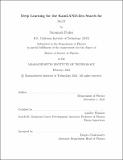| dc.contributor.advisor | Winslow, Lindley | |
| dc.contributor.author | Fraker, Suzannah | |
| dc.date.accessioned | 2022-06-15T13:11:01Z | |
| dc.date.available | 2022-06-15T13:11:01Z | |
| dc.date.issued | 2022-02 | |
| dc.date.submitted | 2022-05-25T22:43:34.180Z | |
| dc.identifier.uri | https://hdl.handle.net/1721.1/143302 | |
| dc.description.abstract | Neutrinoless double beta decay (0𝜈𝛽𝛽) is a major interest in neutrino physics. Discovery of 0𝜈𝛽𝛽 would demonstrate that neutrinos are Majorana fermions and that lepton number is not a symmetry of nature, thus providing a possible explanation for the observed matter-antimatter asymmetry of the universe. KamLAND-Zen is a leading search for 0𝜈𝛽𝛽, having placed the most stringent limit on its half-life at [formula] at 90% C.L. in ¹³⁶Xe. The next phase of KamLAND-Zen is currently running and will place even more stringent limits on the half-life. The sensitivity of KamLAND-Zen is primarily limited by backgrounds, including the muon spallation background ¹⁰C. We present a machine learning algorithm based on a convolutional neural network (CNN) that is able to separate ¹⁰C events from 136Xe events in Monte Carlo simulated data. With a typical kiloton-scale detector configuration like the KamLAND-Zen detector, we find that the algorithm is capable of identifying 61.6% of the ¹⁰C at 90% signal acceptance. The algorithm is independent of vertex and energy reconstruction, so it is complementary to current methods and can be expanded to other background sources. | |
| dc.publisher | Massachusetts Institute of Technology | |
| dc.rights | In Copyright - Educational Use Permitted | |
| dc.rights | Copyright MIT | |
| dc.rights.uri | http://rightsstatements.org/page/InC-EDU/1.0/ | |
| dc.title | Deep Learning for the KamLAND-Zen Search for 0𝜈𝛽𝛽 | |
| dc.type | Thesis | |
| dc.description.degree | S.M. | |
| dc.contributor.department | Massachusetts Institute of Technology. Department of Physics | |
| mit.thesis.degree | Master | |
| thesis.degree.name | Master of Science in Physics | |
